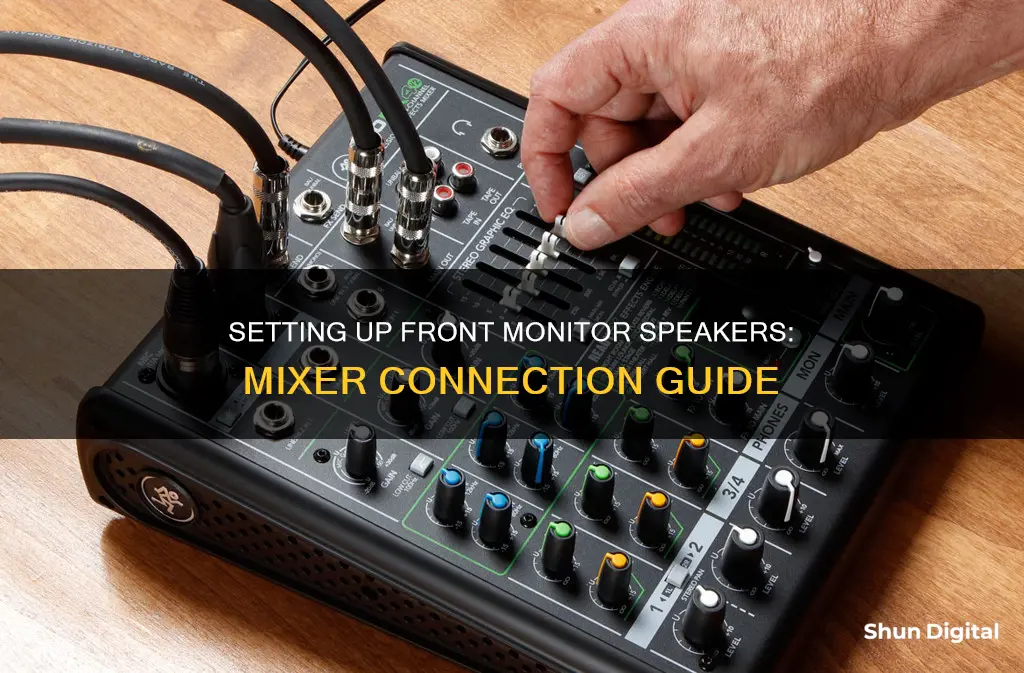
Setting up front monitor speakers to a mixer can be done in a few simple steps. First, power off the speakers and mixer board, and position the speakers in the desired location. Next, connect the speaker cables to the mixer board, typically using the L and R jacks for left and right channels. Some mixers have a monitor system, so you may see labels like L/Monitor and R/L+R. Plug in the speaker cables accordingly, and if using a monitor setup, daisy chain the speakers by plugging the cable from the mixer into one speaker, and then connecting the second speaker to the first. Finally, connect the power cords to the speakers and mixer, and turn them on. This setup allows performers to hear themselves and their bandmates, and monitor volume levels during performances.
What You'll Learn

Connecting active vs. passive speakers
Active speakers have a built-in amplifier, so the signal does not need to be amplified by the mixer. Passive speakers, on the other hand, require an external power amplifier to pass the signal. If you are using a passive mixer, you will need to connect it to an external power amplifier, and then connect the amplifier to the passive speakers.
If you are using an active mixer, it is important to note that the signal will already be amplified by the mixer. Connecting this amplified signal to active speakers could be too strong for the speakers to handle and may cause severe damage to your equipment. Instead, it is recommended to use passive speakers with an active mixer to avoid this issue.
When connecting speakers to a mixer, it is important to use the correct cables. Balanced cables, such as XLR or TRS cables, are recommended as they provide better noise rejection and allow for longer cable runs without interference. Unbalanced cables, such as TS or RCA cables, are more susceptible to picking up noise and interference and have shorter maximum length recommendations.
Additionally, the placement of the speakers is important. Start by placing the monitors 3-5 feet in front of each performer or group of performers. The ideal location is somewhere in front of the performer(s) and pointed away from as many mics as possible to eliminate the chance of feedback.
Removing Ants from LCD Monitors: A Step-by-Step Guide
You may want to see also

Using balanced vs. unbalanced cables
When connecting front monitor speakers to a mixer, it is important to consider the type of cable used, as this can impact the sound quality and the amount of interference in the audio signal. The two main types of cables used in audio setups are balanced and unbalanced cables, each with its own advantages and use cases.
Balanced cables are designed to carry two identical versions of the audio signal, with one signal being phase-inverted. When the signals reach the destination, they are compared to reject noise and interference. This makes balanced cables ideal for longer cable runs, typically up to 600 feet or more, as they can maintain audio quality without significant signal loss. Additionally, balanced cables are less susceptible to picking up noise and interference, resulting in a cleaner and clearer audio signal. The most common types of balanced cables are XLR cables and TRS (Tip, Ring, Sleeve) cables, which can be used for both mono and stereo audio signals.
On the other hand, unbalanced cables carry only one version of the audio signal and are more susceptible to noise and interference. Unbalanced cables are typically used for shorter cable runs, usually less than 15 feet, to minimise the risk of interference. Unbalanced cables are commonly used in situations where the audio source is close to the destination, such as connecting a guitar to a nearby amplifier. The most common type of unbalanced cable is the TS (Tip, Sleeve) cable, which is often used with electric guitars.
When deciding between balanced and unbalanced cables for connecting front monitor speakers to a mixer, it is important to consider the distance between the mixer and the speakers, as well as the presence of potential sources of interference. If the distance is greater than 15 feet or if there are multiple electrical devices nearby, it is generally recommended to use balanced cables to minimise interference and maintain audio quality. However, if the distance is relatively short and the environment is less prone to interference, unbalanced cables can also be used.
Additionally, it is important to check the inputs and outputs of the mixer and speakers to ensure compatibility with the chosen cable type. Most studio monitor speakers and mixers support balanced cables, but it is always a good idea to verify before making a purchase.
Wireless Monitor Setup for Your Loudbox Mini
You may want to see also

Speaker placement
The placement of your monitor speakers is crucial to achieving the best sound quality. Here are some tips to optimise your setup:
Symmetry
Arranging your speakers symmetrically within the room can help to minimise any imbalances in sound between the left and right channels. Position your speakers along the shorter wall of the room, avoiding corners, and aim them towards your listening position.
Ear Level
The ideal height for your speakers is so that the tweeters are at ear level when you are sitting or standing in your usual listening position. This ensures the most consistent sound dispersion. If your speakers are too low, consider using speaker stands to elevate them.
Avoid Reflections
Hard, flat surfaces such as windows, drywall, and plaster walls can cause sound reflections that interfere with the direct sound from the speakers. Try to position your speakers away from these surfaces, and use acoustic treatment such as foam panels to reduce reflections if necessary.
Adjust Speaker Angle
Angle your speakers towards your listening position at a 30-degree angle to the centre line. This helps to achieve accurate stereo imaging. You may also need to tilt the speakers slightly to aim the tweeters directly at your ears.
Avoid Early Reflections
Place your speakers behind your console or desktop to avoid early reflections off nearby surfaces, which can colour the sound. Use speaker stands or place the speakers on foam blocks to decouple them from the surface and prevent vibrations from affecting the sound.
Experiment with Speaker Height
There is an ongoing debate about whether to position the speakers with the tweeter or the woofer at ear level. The best approach is to experiment with both setups and choose the one that sounds best to you.
Monitoring Bandwidth Usage: Android Tips and Tricks
You may want to see also

Connecting to a power source
Connecting your front monitor speakers to a power source involves several steps. Firstly, ensure that both your speakers and mixer board are powered off. This is important for safety reasons and to avoid any potential damage to the equipment. Position your speakers in your desired location, and lay out the speaker cables, coiling any excess cable at the bottom of the speaker stands.
The next step is to plug in the speaker cables. For a basic setup, connect the left speaker cable to the "L" jack on the mixer board and the right cable to the "R" jack. Some mixers have a monitor system, so you may see labels like "L/Monitor" and "R/L+R". If you're using a monitor setup, you can daisy-chain the speakers. Plug one speaker cable into the "L+R" jack on the mixer, and then connect the other speaker to the first one. This leaves the monitor jack on the mixer free for your monitors.
After plugging in the cables, connect the power cords to your speakers and plug them into power outlets. Ensure that the power cords are securely connected to the speakers and the outlets. Once everything is plugged in, you can power on both the speakers and the mixer.
It's important to note that the volume sliders on the mixer correspond to the jacks for the speakers. You can adjust the volume for the left and right channels separately. If you're using a monitor, you can also adjust its volume independently from the main speakers. Additionally, make sure not to run a separate amplifier with your amplified speakers, as this could potentially damage your equipment.
Crafting LCD Monitors: Step-by-Step Guide to Manufacturing
You may want to see also

Adjusting the monitor mix
Understanding Monitor Mix Requirements
Before adjusting the monitor mix, it's essential to understand the requirements of the musicians and the overall performance. Musicians need to feel confident in their performance, and this stems from being able to hear themselves and their bandmates clearly. The monitor mix should provide clarity, allowing the lead singer to hear their voice and the band, and enabling band members to follow the lead singer and stay in sync. Each performer may have specific requirements, such as hearing certain instruments more clearly or preferring a particular balance of vocals and instruments.
Setting Up the Monitor Mix
To set up a basic monitor mix, start by turning up one of the Aux sends on a channel strip. This routes the channel to an Aux Master, which is then sent to an output on the mixer and the respective stage monitor. You'll need to balance the Aux send levels to meet the performer's needs, considering their position on stage and their unique requirements. It's recommended to finalise monitor mixes with performers while the mains are on, so both the sound engineer and musicians can acclimate to the overall sound.
Technical Considerations
When adjusting the monitor mix, it's important to ensure a clear and undistorted sound. This means paying attention to EQ, compression, and reverb, applying these treatments on an instrument-by-instrument basis rather than to the entire monitor output. While monitors don't require an extremely extended low-frequency response, they do need a firm and punchy bass to cut through the 'mush' of room reflections. Additionally, be cautious not to over-emphasise high-mid and high frequencies, as this can lead to harsh and fatiguing monitor sound.
Managing Feedback
One of the biggest challenges in monitor mixing is managing feedback. To minimise feedback, place microphones as close to the sound source as possible, angle mics and speakers away from each other, and keep monitor levels as low as practical. Equalisation is also a powerful tool for feedback control, allowing you to identify and reduce the gain at offending frequencies. Graphic equalisers can be particularly useful for this purpose, providing individual control for each monitor and helping to optimise feedback suppression for each performer.
In-Ear Monitoring and Other Options
While traditional stage monitors are common, in-ear monitoring is gaining popularity. In-ear monitoring eliminates sound spill and provides a direct and clear monitor mix to each performer. However, it can make the performer feel disconnected from the audience, so it's important to consider the trade-offs. Other options, such as using headphones or a combination of wedges and in-ear monitors, can also be explored to find the best solution for each performer and the overall performance.
The Art and Science of Monitor Mixing
Creating a good monitor mix is both an art and a science. It requires technical knowledge, an understanding of the performers' needs, and a delicate touch to balance the various elements of the mix. While this guide provides a starting point, the best monitor mixes come from experience, experimentation, and a deep understanding of sound engineering principles.
Removing the ASUS ROG Swift Monitor Stand: A Step-by-Step Guide
You may want to see also
Frequently asked questions
First, power off both the speakers and the mixer board. Position the speakers where you want them and lay out the speaker cable so that the excess cable is coiled at the bottom of the speaker stands. Plug in the left speaker cable to the "L" jack on the back of the mixer board and the right cable to the "R" jack. Note that some mixers will have a monitor system, so you might see "L/Monitor" for one jack and "R/L+R" for the other jack. There will be a switch on the mixer that allows you to select the use of the monitor and the speakers or just the speakers.
We recommend using balanced TRS cables where possible. If your speakers only have XLR inputs, you can use a 1/4" TRS to XLR cable.
If you have passive monitor speakers, you will need to connect them to an amplifier. Plug the AUX cable into the sound mixer, then insert the other end of the cable into your amp. Run a line from your amp to your monitor speaker, confirming whether your monitor requires an XLR plug, easy-lock connector, or quarter-inch plug.







